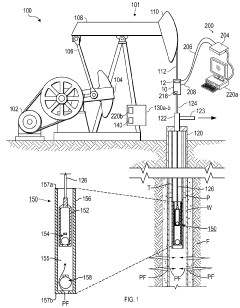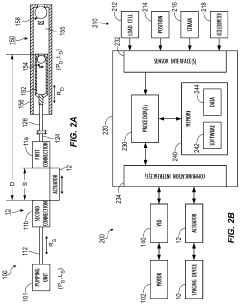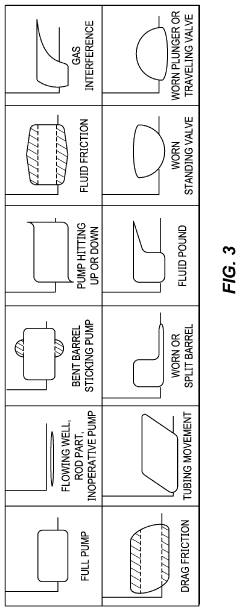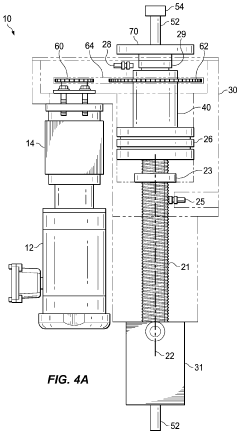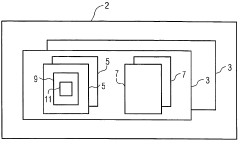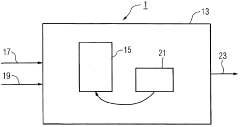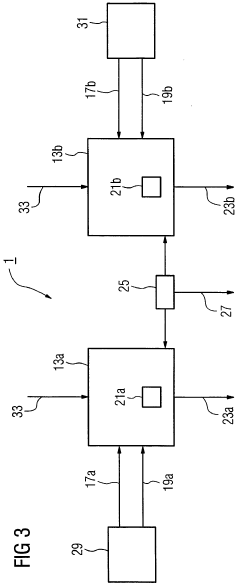Using AI for enhancing submersible pump operational reliability.
JUL 15, 20259 MIN READ
Generate Your Research Report Instantly with AI Agent
Patsnap Eureka helps you evaluate technical feasibility & market potential.
AI in Submersible Pumps: Background and Objectives
Submersible pumps have been a cornerstone in various industries, including oil and gas, water supply, and wastewater management, for decades. These robust devices operate in challenging environments, often submerged in fluids and subjected to extreme pressures and temperatures. As the demand for operational efficiency and reliability continues to grow, the integration of Artificial Intelligence (AI) into submersible pump systems has emerged as a promising solution to enhance their performance and longevity.
The evolution of submersible pump technology has been marked by incremental improvements in materials, design, and control systems. However, the introduction of AI represents a paradigm shift in how these pumps are operated and maintained. This technological leap aims to address persistent challenges such as unexpected failures, inefficient energy consumption, and suboptimal performance under varying conditions.
The primary objective of incorporating AI into submersible pump operations is to significantly improve their operational reliability. This encompasses several key goals: predictive maintenance to prevent unexpected breakdowns, real-time performance optimization, and adaptive control systems that can respond to changing environmental conditions. By leveraging machine learning algorithms and advanced data analytics, AI systems can process vast amounts of sensor data to detect anomalies, predict potential failures, and optimize pump operations in ways that were previously impossible with traditional control methods.
Another critical objective is to enhance the energy efficiency of submersible pumps. AI-driven systems can continuously analyze operational data to identify inefficiencies and adjust pump parameters in real-time, potentially leading to substantial energy savings and reduced operational costs. This aligns with the growing global emphasis on sustainability and energy conservation across industries.
The integration of AI also aims to extend the lifespan of submersible pumps by enabling more precise and proactive maintenance strategies. By accurately predicting when components are likely to fail, maintenance can be scheduled at optimal times, reducing downtime and preventing catastrophic failures that could result in costly repairs or replacements.
Furthermore, the application of AI in submersible pumps seeks to improve overall system reliability in complex installations, such as offshore oil platforms or municipal water systems. By analyzing data from multiple pumps and related equipment simultaneously, AI can optimize the performance of entire pump networks, ensuring more stable and efficient operations across the system.
As we explore the potential of AI in enhancing submersible pump reliability, it is crucial to consider the technological trends that are shaping this field. These include the development of more sophisticated sensors, edge computing capabilities for real-time data processing, and advanced AI algorithms capable of handling the complexities of fluid dynamics and mechanical systems. The convergence of these technologies promises to revolutionize the operation and maintenance of submersible pumps, setting new standards for reliability and efficiency in the industry.
The evolution of submersible pump technology has been marked by incremental improvements in materials, design, and control systems. However, the introduction of AI represents a paradigm shift in how these pumps are operated and maintained. This technological leap aims to address persistent challenges such as unexpected failures, inefficient energy consumption, and suboptimal performance under varying conditions.
The primary objective of incorporating AI into submersible pump operations is to significantly improve their operational reliability. This encompasses several key goals: predictive maintenance to prevent unexpected breakdowns, real-time performance optimization, and adaptive control systems that can respond to changing environmental conditions. By leveraging machine learning algorithms and advanced data analytics, AI systems can process vast amounts of sensor data to detect anomalies, predict potential failures, and optimize pump operations in ways that were previously impossible with traditional control methods.
Another critical objective is to enhance the energy efficiency of submersible pumps. AI-driven systems can continuously analyze operational data to identify inefficiencies and adjust pump parameters in real-time, potentially leading to substantial energy savings and reduced operational costs. This aligns with the growing global emphasis on sustainability and energy conservation across industries.
The integration of AI also aims to extend the lifespan of submersible pumps by enabling more precise and proactive maintenance strategies. By accurately predicting when components are likely to fail, maintenance can be scheduled at optimal times, reducing downtime and preventing catastrophic failures that could result in costly repairs or replacements.
Furthermore, the application of AI in submersible pumps seeks to improve overall system reliability in complex installations, such as offshore oil platforms or municipal water systems. By analyzing data from multiple pumps and related equipment simultaneously, AI can optimize the performance of entire pump networks, ensuring more stable and efficient operations across the system.
As we explore the potential of AI in enhancing submersible pump reliability, it is crucial to consider the technological trends that are shaping this field. These include the development of more sophisticated sensors, edge computing capabilities for real-time data processing, and advanced AI algorithms capable of handling the complexities of fluid dynamics and mechanical systems. The convergence of these technologies promises to revolutionize the operation and maintenance of submersible pumps, setting new standards for reliability and efficiency in the industry.
Market Analysis for AI-Enhanced Pump Systems
The market for AI-enhanced submersible pump systems is experiencing significant growth, driven by increasing demand for efficient and reliable pumping solutions across various industries. The global submersible pump market, valued at approximately $11.3 billion in 2020, is projected to reach $19.1 billion by 2028, with AI-enhanced systems expected to capture a substantial portion of this growth.
Key industries driving the demand for AI-enhanced submersible pumps include oil and gas, water and wastewater management, mining, and agriculture. In the oil and gas sector, the need for improved operational efficiency and reduced downtime is particularly acute, with AI-enabled predictive maintenance capabilities offering substantial cost savings and productivity gains.
The water and wastewater management sector is another major market for AI-enhanced submersible pumps, as municipalities and industrial facilities seek to optimize their operations and reduce energy consumption. The increasing focus on water conservation and sustainable resource management is further propelling the adoption of smart pumping solutions.
Market trends indicate a growing preference for integrated AI solutions that offer real-time monitoring, predictive maintenance, and performance optimization. End-users are increasingly recognizing the value of AI in reducing operational costs, extending equipment lifespan, and improving overall system reliability.
Geographically, North America and Europe are currently leading the adoption of AI-enhanced submersible pump systems, owing to their advanced industrial infrastructure and higher investment in technological innovation. However, the Asia-Pacific region is expected to witness the fastest growth in the coming years, driven by rapid industrialization, urbanization, and increasing water management challenges.
The competitive landscape of the AI-enhanced submersible pump market is characterized by a mix of established pump manufacturers integrating AI capabilities into their products and new entrants specializing in AI-driven pump solutions. Key players are focusing on developing user-friendly interfaces, cloud-based analytics platforms, and seamless integration with existing industrial control systems to gain a competitive edge.
Challenges in market adoption include the initial high cost of AI-enabled systems, concerns about data security and privacy, and the need for specialized skills to implement and maintain these advanced systems. However, the long-term benefits in terms of reduced operational costs, improved reliability, and enhanced performance are expected to outweigh these initial barriers.
As the technology matures and becomes more accessible, the market for AI-enhanced submersible pump systems is poised for substantial growth. The increasing emphasis on Industry 4.0 and the Internet of Things (IoT) is expected to further accelerate the adoption of AI-driven pumping solutions across various industrial applications.
Key industries driving the demand for AI-enhanced submersible pumps include oil and gas, water and wastewater management, mining, and agriculture. In the oil and gas sector, the need for improved operational efficiency and reduced downtime is particularly acute, with AI-enabled predictive maintenance capabilities offering substantial cost savings and productivity gains.
The water and wastewater management sector is another major market for AI-enhanced submersible pumps, as municipalities and industrial facilities seek to optimize their operations and reduce energy consumption. The increasing focus on water conservation and sustainable resource management is further propelling the adoption of smart pumping solutions.
Market trends indicate a growing preference for integrated AI solutions that offer real-time monitoring, predictive maintenance, and performance optimization. End-users are increasingly recognizing the value of AI in reducing operational costs, extending equipment lifespan, and improving overall system reliability.
Geographically, North America and Europe are currently leading the adoption of AI-enhanced submersible pump systems, owing to their advanced industrial infrastructure and higher investment in technological innovation. However, the Asia-Pacific region is expected to witness the fastest growth in the coming years, driven by rapid industrialization, urbanization, and increasing water management challenges.
The competitive landscape of the AI-enhanced submersible pump market is characterized by a mix of established pump manufacturers integrating AI capabilities into their products and new entrants specializing in AI-driven pump solutions. Key players are focusing on developing user-friendly interfaces, cloud-based analytics platforms, and seamless integration with existing industrial control systems to gain a competitive edge.
Challenges in market adoption include the initial high cost of AI-enabled systems, concerns about data security and privacy, and the need for specialized skills to implement and maintain these advanced systems. However, the long-term benefits in terms of reduced operational costs, improved reliability, and enhanced performance are expected to outweigh these initial barriers.
As the technology matures and becomes more accessible, the market for AI-enhanced submersible pump systems is poised for substantial growth. The increasing emphasis on Industry 4.0 and the Internet of Things (IoT) is expected to further accelerate the adoption of AI-driven pumping solutions across various industrial applications.
Current AI Integration in Submersible Pump Technology
The integration of Artificial Intelligence (AI) in submersible pump technology has been gaining significant traction in recent years. AI-driven solutions are being increasingly deployed to enhance the operational reliability and efficiency of submersible pumps across various industries, including oil and gas, water management, and mining.
One of the primary areas where AI is making a substantial impact is in predictive maintenance. Advanced machine learning algorithms are now capable of analyzing vast amounts of sensor data collected from submersible pumps in real-time. These algorithms can detect subtle changes in pump performance, vibration patterns, and other key parameters that may indicate potential issues or impending failures. By identifying these problems early, maintenance teams can proactively address them before they escalate into costly breakdowns or operational disruptions.
AI-powered monitoring systems are also being implemented to optimize pump performance continuously. These systems use sophisticated data analytics to adjust pump settings automatically, ensuring optimal operation under varying conditions. For instance, in the oil and gas industry, AI algorithms can adapt pump speeds and pressures based on changing well conditions, maximizing production while minimizing energy consumption and wear on equipment.
Another significant application of AI in submersible pump technology is in fault diagnosis and troubleshooting. Machine learning models trained on historical pump failure data can quickly identify the root causes of operational issues, significantly reducing downtime and maintenance costs. These AI systems can often provide detailed insights into the nature of the problem and recommend specific corrective actions, enabling even less experienced technicians to address complex issues effectively.
AI is also being leveraged to improve the design and selection of submersible pumps. By analyzing vast datasets of pump performance across different operating conditions, AI algorithms can assist engineers in optimizing pump designs for specific applications. This data-driven approach leads to more efficient and reliable pump systems tailored to the unique requirements of each installation.
Furthermore, AI-enabled digital twins are emerging as a powerful tool in submersible pump technology. These virtual replicas of physical pump systems allow operators to simulate various scenarios and test different operational strategies without risking actual equipment. By running these simulations, companies can identify optimal operating parameters, predict long-term performance, and develop more effective maintenance strategies.
While the current integration of AI in submersible pump technology shows great promise, it is important to note that the field is still evolving. Challenges remain in areas such as data quality, sensor reliability, and the integration of AI systems with existing infrastructure. However, as these challenges are addressed and AI technologies continue to advance, the potential for further enhancing submersible pump operational reliability through AI is substantial.
One of the primary areas where AI is making a substantial impact is in predictive maintenance. Advanced machine learning algorithms are now capable of analyzing vast amounts of sensor data collected from submersible pumps in real-time. These algorithms can detect subtle changes in pump performance, vibration patterns, and other key parameters that may indicate potential issues or impending failures. By identifying these problems early, maintenance teams can proactively address them before they escalate into costly breakdowns or operational disruptions.
AI-powered monitoring systems are also being implemented to optimize pump performance continuously. These systems use sophisticated data analytics to adjust pump settings automatically, ensuring optimal operation under varying conditions. For instance, in the oil and gas industry, AI algorithms can adapt pump speeds and pressures based on changing well conditions, maximizing production while minimizing energy consumption and wear on equipment.
Another significant application of AI in submersible pump technology is in fault diagnosis and troubleshooting. Machine learning models trained on historical pump failure data can quickly identify the root causes of operational issues, significantly reducing downtime and maintenance costs. These AI systems can often provide detailed insights into the nature of the problem and recommend specific corrective actions, enabling even less experienced technicians to address complex issues effectively.
AI is also being leveraged to improve the design and selection of submersible pumps. By analyzing vast datasets of pump performance across different operating conditions, AI algorithms can assist engineers in optimizing pump designs for specific applications. This data-driven approach leads to more efficient and reliable pump systems tailored to the unique requirements of each installation.
Furthermore, AI-enabled digital twins are emerging as a powerful tool in submersible pump technology. These virtual replicas of physical pump systems allow operators to simulate various scenarios and test different operational strategies without risking actual equipment. By running these simulations, companies can identify optimal operating parameters, predict long-term performance, and develop more effective maintenance strategies.
While the current integration of AI in submersible pump technology shows great promise, it is important to note that the field is still evolving. Challenges remain in areas such as data quality, sensor reliability, and the integration of AI systems with existing infrastructure. However, as these challenges are addressed and AI technologies continue to advance, the potential for further enhancing submersible pump operational reliability through AI is substantial.
Existing AI Implementations for Pump Reliability
01 Improved pump design for reliability
Enhancing the design of submersible pumps to improve operational reliability. This includes optimizing components such as impellers, seals, and bearings to withstand harsh underwater conditions and prolonged operation. Advanced materials and manufacturing techniques are employed to increase durability and reduce wear and tear.- Improved pump design for reliability: Enhancing the design of submersible pumps to improve operational reliability. This includes optimizing components such as impellers, seals, and bearings to withstand harsh underwater conditions and prolonged operation. Advanced materials and manufacturing techniques are employed to increase durability and reduce wear and tear.
- Monitoring and control systems: Implementation of sophisticated monitoring and control systems to enhance the operational reliability of submersible pumps. These systems include sensors for real-time performance monitoring, automated fault detection, and remote operation capabilities. They allow for predictive maintenance and quick response to potential issues, minimizing downtime and extending pump life.
- Thermal management solutions: Development of effective thermal management solutions to maintain optimal operating temperatures for submersible pumps. This involves innovative cooling systems, heat-resistant materials, and designs that facilitate efficient heat dissipation. Proper thermal management prevents overheating, reduces wear on components, and extends the pump's operational lifespan.
- Corrosion and erosion protection: Implementation of advanced corrosion and erosion protection measures to enhance the longevity and reliability of submersible pumps. This includes the use of corrosion-resistant materials, protective coatings, and cathodic protection systems. These measures safeguard the pump against the harsh underwater environment and abrasive particles in the pumped fluid.
- Modular and serviceable design: Adoption of modular and easily serviceable designs for submersible pumps to improve maintenance efficiency and reduce downtime. This approach allows for quick replacement of worn components, easier troubleshooting, and simplified overhaul procedures. The modular design also enables customization for specific operational requirements, enhancing overall reliability and performance.
02 Monitoring and control systems
Implementation of sophisticated monitoring and control systems to enhance the operational reliability of submersible pumps. These systems include sensors for real-time performance monitoring, automated fault detection, and remote diagnostics. Advanced control algorithms optimize pump operation and prevent failures by adjusting to changing conditions.Expand Specific Solutions03 Thermal management solutions
Development of effective thermal management solutions to maintain optimal operating temperatures for submersible pumps. This involves innovative cooling systems, heat dissipation techniques, and temperature-resistant materials to prevent overheating and extend the pump's lifespan in challenging underwater environments.Expand Specific Solutions04 Corrosion and erosion protection
Implementation of advanced corrosion and erosion protection measures to enhance the operational reliability of submersible pumps. This includes the use of corrosion-resistant materials, protective coatings, and cathodic protection systems to prevent degradation of pump components in aggressive underwater environments.Expand Specific Solutions05 Maintenance and serviceability improvements
Enhancements in the design and construction of submersible pumps to improve maintenance and serviceability. This includes modular designs for easy component replacement, self-diagnostic capabilities, and innovative access solutions for underwater maintenance. These improvements reduce downtime and extend the operational life of the pumps.Expand Specific Solutions
Key Players in AI-Driven Pump Solutions
The market for AI-enhanced submersible pump operational reliability is in its growth phase, with increasing adoption across industries. The global market size is projected to expand significantly due to rising demand for efficient and reliable pumping solutions in sectors like oil & gas, water management, and mining. Technologically, the field is advancing rapidly, with key players like Schlumberger, Baker Hughes, and Siemens leading innovation. These companies are leveraging AI and machine learning to develop predictive maintenance systems, optimize pump performance, and enhance overall reliability. Emerging players such as IDEX Health & Science and ShinMaywa Industries are also contributing to technological advancements, indicating a competitive and dynamic market landscape.
Schlumberger Technologies, Inc.
Technical Solution: Schlumberger has developed an AI-driven predictive maintenance system for submersible pumps, leveraging machine learning algorithms to analyze real-time sensor data. This system uses advanced pattern recognition to detect anomalies and predict potential failures before they occur[1]. The AI model is trained on vast historical datasets from global operations, enabling it to identify subtle indicators of pump degradation across various operating conditions[3]. Schlumberger's solution also incorporates digital twin technology, creating virtual replicas of physical pumps to simulate performance under different scenarios, thereby optimizing operational parameters and extending pump lifespan[5].
Strengths: Global data resources for robust AI training, integrated with existing oilfield management systems. Weaknesses: May require significant initial investment for smaller operators, potential cybersecurity concerns with connected systems.
Baker Hughes Co.
Technical Solution: Baker Hughes has implemented an AI-powered Remote Operations Center for submersible pump management. This system utilizes machine learning algorithms to continuously monitor pump performance, fluid dynamics, and environmental factors. The AI analyzes multidimensional data streams, including vibration patterns, temperature fluctuations, and power consumption metrics, to provide real-time insights and predictive maintenance recommendations[2]. Baker Hughes' solution also incorporates adaptive control algorithms that automatically adjust pump parameters based on changing well conditions, optimizing efficiency and reducing wear[4]. The system is designed with edge computing capabilities, allowing for rapid decision-making even in areas with limited connectivity[6].
Strengths: Comprehensive integration of AI with remote operations, adaptive control for dynamic environments. Weaknesses: May require specialized training for operators, potential over-reliance on automation in critical situations.
Core AI Innovations for Pump Operations
Automated Sucker Rod Spacing Device and Associated Methods
PatentActiveUS20200182028A1
Innovation
- An automated system that uses sensors and actuators to monitor and adjust the depth of sucker rod strings, incorporating load cells, accelerometers, and a control system to prevent tagging and gas lock, allowing for real-time adjustments and remote monitoring.
Method and device for monitoring a technical installation comprising several systems, in particular an electric power station
PatentWO2004034166A1
Innovation
- A device and method utilizing a dynamic model improved by AI-based algorithms, including neural networks, fuzzy logic, and genetic algorithms, to analyze and predict system performance by integrating previously unaccounted data and relationships, enabling early detection of creeping process deviations and optimizing control systems.
Environmental Impact of AI-Enhanced Pumps
The integration of AI-enhanced submersible pumps in various industries has significant implications for environmental sustainability. These advanced pumps, equipped with artificial intelligence capabilities, offer improved operational efficiency and reduced energy consumption compared to traditional models. By optimizing pump performance based on real-time data analysis, AI-enhanced pumps can minimize unnecessary energy usage and extend equipment lifespan, thereby reducing the overall environmental footprint of pump operations.
One of the key environmental benefits of AI-enhanced submersible pumps is their ability to adapt to changing conditions. Through continuous monitoring and adjustment of operational parameters, these pumps can maintain optimal performance levels across diverse environmental scenarios. This adaptability not only ensures consistent efficiency but also minimizes the risk of equipment failure or malfunction, which could potentially lead to environmental hazards such as leaks or spills.
Furthermore, the predictive maintenance capabilities of AI-enhanced pumps contribute to environmental protection by preventing unexpected breakdowns and reducing the need for frequent replacements. By accurately forecasting maintenance requirements, these systems help minimize waste generation associated with premature equipment disposal and reduce the environmental impact of manufacturing and transporting replacement parts.
In water management applications, AI-enhanced submersible pumps play a crucial role in conservation efforts. By precisely controlling water flow and pressure based on demand patterns and environmental factors, these pumps help prevent water waste and reduce the energy required for water distribution. This optimization is particularly valuable in regions facing water scarcity or struggling with aging infrastructure.
The implementation of AI-enhanced pumps also has positive implications for ecosystem preservation, especially in sensitive environments. In applications such as wastewater treatment or industrial processes, the improved accuracy and responsiveness of these pumps can help maintain strict environmental standards, reducing the risk of pollutant discharge and protecting aquatic ecosystems.
However, it is important to consider the potential environmental trade-offs associated with the widespread adoption of AI-enhanced submersible pumps. The production and disposal of advanced electronic components and sensors required for these systems may have their own environmental implications, including resource extraction and e-waste management challenges. Additionally, the increased reliance on data centers and cloud computing for AI processing may contribute to higher energy consumption in other parts of the operational chain.
One of the key environmental benefits of AI-enhanced submersible pumps is their ability to adapt to changing conditions. Through continuous monitoring and adjustment of operational parameters, these pumps can maintain optimal performance levels across diverse environmental scenarios. This adaptability not only ensures consistent efficiency but also minimizes the risk of equipment failure or malfunction, which could potentially lead to environmental hazards such as leaks or spills.
Furthermore, the predictive maintenance capabilities of AI-enhanced pumps contribute to environmental protection by preventing unexpected breakdowns and reducing the need for frequent replacements. By accurately forecasting maintenance requirements, these systems help minimize waste generation associated with premature equipment disposal and reduce the environmental impact of manufacturing and transporting replacement parts.
In water management applications, AI-enhanced submersible pumps play a crucial role in conservation efforts. By precisely controlling water flow and pressure based on demand patterns and environmental factors, these pumps help prevent water waste and reduce the energy required for water distribution. This optimization is particularly valuable in regions facing water scarcity or struggling with aging infrastructure.
The implementation of AI-enhanced pumps also has positive implications for ecosystem preservation, especially in sensitive environments. In applications such as wastewater treatment or industrial processes, the improved accuracy and responsiveness of these pumps can help maintain strict environmental standards, reducing the risk of pollutant discharge and protecting aquatic ecosystems.
However, it is important to consider the potential environmental trade-offs associated with the widespread adoption of AI-enhanced submersible pumps. The production and disposal of advanced electronic components and sensors required for these systems may have their own environmental implications, including resource extraction and e-waste management challenges. Additionally, the increased reliance on data centers and cloud computing for AI processing may contribute to higher energy consumption in other parts of the operational chain.
Regulatory Framework for AI in Industrial Equipment
The regulatory framework for AI in industrial equipment, particularly in the context of enhancing submersible pump operational reliability, is a complex and evolving landscape. As AI technologies continue to advance and find applications in various industrial sectors, governments and regulatory bodies are working to establish guidelines and standards to ensure safety, reliability, and ethical use of these systems.
In the United States, the National Institute of Standards and Technology (NIST) has been at the forefront of developing AI standards for industrial applications. Their AI Risk Management Framework provides guidance on identifying, assessing, and mitigating risks associated with AI systems in industrial settings. This framework is particularly relevant for AI-enhanced submersible pumps, as it addresses issues such as system reliability, data quality, and algorithmic bias.
The European Union has taken a proactive approach with its proposed AI Act, which aims to categorize AI systems based on their risk levels. For submersible pumps utilizing AI for operational reliability, this regulation would likely classify them as "high-risk" AI systems, given their potential impact on safety and critical infrastructure. This classification would require manufacturers to comply with stringent requirements, including risk assessments, data governance, and human oversight.
In the industrial equipment sector, the International Electrotechnical Commission (IEC) has been developing standards specific to AI applications. The IEC 63243 series focuses on functional safety and AI for industrial applications, providing guidelines for integrating AI into safety-critical systems like submersible pumps. These standards address key aspects such as data integrity, model validation, and system performance monitoring.
The Occupational Safety and Health Administration (OSHA) in the United States has also begun to consider the implications of AI in industrial settings. While specific regulations for AI-enhanced equipment are still in development, OSHA's existing framework for machine safety and risk assessment is being adapted to include AI-specific considerations. This includes evaluating the potential for AI systems to introduce new hazards or alter existing risk profiles in industrial operations.
Globally, the ISO/IEC JTC 1/SC 42 committee is working on international standards for AI, including those applicable to industrial equipment. Their work encompasses areas such as AI trustworthiness, bias in AI systems, and AI in industrial automation, all of which are crucial for the development and deployment of AI-enhanced submersible pumps.
As the regulatory landscape continues to evolve, manufacturers and operators of AI-enhanced submersible pumps must stay informed of emerging standards and regulations. Compliance with these frameworks will be essential not only for legal and regulatory reasons but also for ensuring the safe and reliable operation of these advanced systems in critical industrial applications.
In the United States, the National Institute of Standards and Technology (NIST) has been at the forefront of developing AI standards for industrial applications. Their AI Risk Management Framework provides guidance on identifying, assessing, and mitigating risks associated with AI systems in industrial settings. This framework is particularly relevant for AI-enhanced submersible pumps, as it addresses issues such as system reliability, data quality, and algorithmic bias.
The European Union has taken a proactive approach with its proposed AI Act, which aims to categorize AI systems based on their risk levels. For submersible pumps utilizing AI for operational reliability, this regulation would likely classify them as "high-risk" AI systems, given their potential impact on safety and critical infrastructure. This classification would require manufacturers to comply with stringent requirements, including risk assessments, data governance, and human oversight.
In the industrial equipment sector, the International Electrotechnical Commission (IEC) has been developing standards specific to AI applications. The IEC 63243 series focuses on functional safety and AI for industrial applications, providing guidelines for integrating AI into safety-critical systems like submersible pumps. These standards address key aspects such as data integrity, model validation, and system performance monitoring.
The Occupational Safety and Health Administration (OSHA) in the United States has also begun to consider the implications of AI in industrial settings. While specific regulations for AI-enhanced equipment are still in development, OSHA's existing framework for machine safety and risk assessment is being adapted to include AI-specific considerations. This includes evaluating the potential for AI systems to introduce new hazards or alter existing risk profiles in industrial operations.
Globally, the ISO/IEC JTC 1/SC 42 committee is working on international standards for AI, including those applicable to industrial equipment. Their work encompasses areas such as AI trustworthiness, bias in AI systems, and AI in industrial automation, all of which are crucial for the development and deployment of AI-enhanced submersible pumps.
As the regulatory landscape continues to evolve, manufacturers and operators of AI-enhanced submersible pumps must stay informed of emerging standards and regulations. Compliance with these frameworks will be essential not only for legal and regulatory reasons but also for ensuring the safe and reliable operation of these advanced systems in critical industrial applications.
Unlock deeper insights with Patsnap Eureka Quick Research — get a full tech report to explore trends and direct your research. Try now!
Generate Your Research Report Instantly with AI Agent
Supercharge your innovation with Patsnap Eureka AI Agent Platform!
